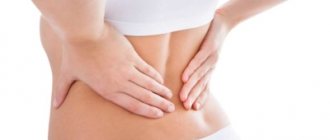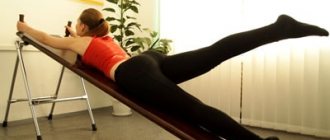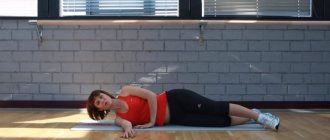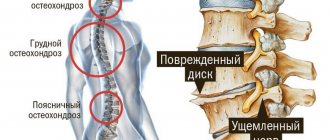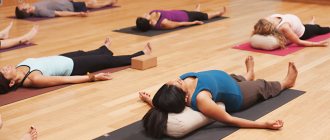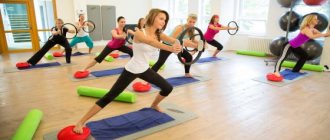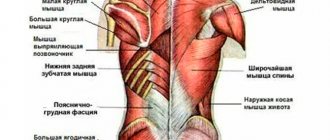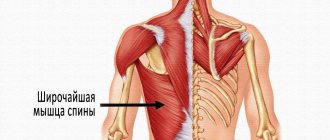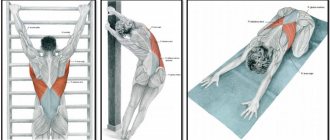Lumbosacral hernia is a complex pathological lesion that is quite difficult to treat. The patient constantly feels discomfort, in particular, when in a sitting position and during physical activity, turning and bending cause pain. There are many methods of combating this disease, and one of the most effective is gymnastics for a hernia of the lumbosacral region, which has almost no restrictions and allows you to achieve good results.
Optimal time for classes
Perform a set of exercises accompanied by calm music or background sounds of nature.
Therapeutic exercise for a lumbar hernia will bring maximum therapeutic effect if the set of exercises is performed not only daily and 2 times, but also at a certain time of day. However, rare “truancy” from evening classes is acceptable if you have to attend late-ending entertainment events, especially those involving drinking alcohol.
The presented instructions are not unshakable - the time indicated in it can be shifted slightly:
- 06:00 – after waking up, you need to drink 100-200 ml of warm still water;
- 06:30 – perform a set of exercises, and then water procedures;
- 07:20 – breakfast;
- 18-30 – dinner;
- 20:00 – performing a set of exercises, evening dressing;
- 22:00 – you should drink a glass of kefir or unsweetened rosehip tea;
- 23:00 – going to bed.
The key to training effectiveness
Exercises for the spine with a hernia are so diverse that it is easier to convey their principle than to list everything.
As you understand, the above is only a small part of all existing options.
Graduality
The first stage is the initial restoration of leg mobility and muscle stretching. All movements are performed so that the lower back does not receive much load.
The next stage - you can already perform pelvic lifts, pumps, folds with legs bent at the knees and a slight lifting of the body.
The main thing is to gradually strengthen the muscles so as not to get negative consequences.
Stability and regularity
Consistency in practice is a guaranteed result. If you exercise consistently for a month, you will definitely feel better.
It’s worth saying right away that if, after feeling relief, you stop exercising, the pain will most likely return. After all, the muscles will weaken without training, and the hernia will make itself felt again. Gymnastics is now your constant companion. You can change the exercises, gradually making them more difficult. But you just need to do it several times a week.
If you have a herniated spine, exercise is the key to your well-being. You can live your whole life with a hernia and without pain.
Rules for performing the complex and warnings
Along with regular exercise therapy, it is important to maintain a drinking regime - 1.5-2 liters per day
Therapeutic exercise for lumbosacral hernia is one of the methods of exercise therapy that requires an individual approach. Therefore, this complex is suitable for most, but not everyone.
It is also clear that during infectious diseases, high body temperature, or other types of ailments, for example, food poisoning or a jump in blood pressure, physical therapy for a lumbar hernia is prohibited.
Those who take up this gymnastics will need to strictly adhere to the rules listed below:
| Cautions and contraindications | Rules |
| These exercises are contraindicated for persons with arthrosis, arthritis and injuries of the knee and ankle joints | The complex always begins with a warm-up and ends with final relaxation, and it is forbidden to change exercises in places |
| If you feel pain or feel sick during a session, you should stop. | Strictly adhere to the indicated dosage. More is not better |
| The range of motion should not cause severe discomfort | Perform all movements slowly, smoothly and without jerking |
| These exercises can be done during menstruation and pregnancy | While performing the exercises, make sure to adhere to the specified breathing rhythm. |
Advice! Many people are afraid to do static yoga twists because of the technically difficult positions. Feel free to start performing the asana in a position that you can get into. This will not reduce the therapeutic effect by much, and over time the position in the asana will become technically ideal.
Symptoms
The very first manifestation of a hernia may be indicated by pain in the back . As it “grows,” the pain will only intensify. Swelling is also observed at the site of manifestation of the disease. If at the initial stage the tumor is not visible, then as it grows, the swelling in the area where the disease is located will increase.
In the middle stage of the disease, the hernia is visible in a standing position. As a rule, most patients consult a doctor at this stage of the disease. At the last stage of the disease, a hernia can lead to numbness of the limbs and unbearably acute pain.
Basic and general symptoms:
- Back pain.
- Swelling at the site of localization.
- Feeling of numbness in the limbs.
- Having difficulty moving.
- Fever.
Important! The last stage of the disease is the most dangerous and requires immediate surgical intervention. Because numbness of the limbs can lead to complete paralysis.
Why do you need morning exercises?
Everyone knows that it is necessary to do exercises in the morning, but, in most cases, only athletes and those who strive to lead a healthy lifestyle do it. However, for people suffering from intervertebral hernias, daily warm-up in the morning is not only desirable, but mandatory.
It is one of the forms of exercise therapy, which is considered the only effective treatment method that can stop or slow down the progression of hernial protrusion and other osteochondrosis changes in the spine. There are two types of morning exercises, which, although not radically, differ from each other.
Morning hygienic exercises
Exercises should be simple and not require complex coordination of movements.
Hygienic exercises are performed by healthy people. Its main goal is a smooth transition of the body from sleep to wakefulness.
Hygienic exercise is based on the following principles and rules:
- content - the main types of gymnastic exercises performed in a standing position, jumping, skipping and short running in place;
- tempo and rhythm - smooth and slow at first, and sharply and energetically at the end;
- load - the number of repetitions depends on the physical fitness of the body, should not be large and allow you to perform exercises without pauses.
The duration of the morning gymnastic warm-up should not exceed 15 minutes.
For your information. Modern sports medicine does not recommend that “ordinary” people replace morning exercises with long running. If you want to run, then this should be done in the afternoon and away from highways.
Health-improving morning exercises
“Harmful” and “useful” exercise movements are determined by the disease itself
The main goal of health-improving exercises is the same as that of hygienic exercises – to smoothly “wake up” all systems and prepare the body for the upcoming daily stress. However, this must be done in accordance with the ailment(s) from which the person suffers.
Without being distracted by other diseases, let us look at an example of what requirements health-improving gymnastics should meet for lumbar intervertebral hernia:
- Charging consists of 2 blocks:
- exercises performed in bed immediately after waking up;
- special gymnastic exercises for the lumbar region, which are performed after 10-15 minutes.
- Exercises for the lower back are selected in such a way that the joints of the limbs “wake up” along with the spine.
- All movements, without exception, are performed smoothly and only at a slow pace.
- The number of repetitions of each exercise should not carry training loads!
- It is necessary to alternate exercises aimed at warming up the muscles of the back and abdomen, as well as isometric movements with dynamic ones.
- During each exercise, movements must be coordinated with breathing.
- Gymnastic exercises from the second block are first performed in a lying position on your back and stomach, then in an emphasis on all fours, and then standing.
Due to the slow execution of the exercises, morning exercises for lumbar intervertebral hernia can last up to 20 minutes.
Causes
Intervertebral hernia is a fairly common disease among the population aged 30 years and older. At the moment, there is a trend of “rejuvenation” of the disease among the current generation.
The main reasons for the appearance can be considered:
- osteochondrosis in a fairly advanced state;
- leading a sedentary lifestyle, in most cases due to incorrect position of the back and spine;
- back and cervical spine injuries;
- childbirth;
- too heavy physical exercise or, conversely, lack of it;
- insufficient nutrition during heavy physical labor;
- hereditary predisposition.
Smoking and drinking alcohol also affects the occurrence of intervertebral hernia. The advice of all doctors is to maintain a healthy lifestyle.
Prohibited movements for lumbar hernia
What gymnastic exercises are prohibited to perform with a lumbar hernia can only be suggested by the attending physician or a physical therapy specialist, because pathologies differ in the direction of the protrusion. For example, for some, tilting to the side can be harmful, again, which one - to the left or to the right - can only be said after the diagnosis has been clarified.
However, in most cases, protrusion occurs anteriorly, so we offer you a photo gallery of movements that should be abandoned, both during exercises or therapeutic exercises, and avoided in everyday life.
Price for their implementation:
- exacerbation of the course of degenerative-dystrophic processes;
- return of pain syndrome;
- increased growth in hernia size.
Deadlift
Any forward bending, including in a sitting position
Work lying on the floor without a bolster under the lower back
Abdominal pumping, moving from a lying position to a sitting position
Simultaneous lifting of straight legs, with further movement behind the head
Vertical concussions - jumping, jumping, running in place, including jogging
On a note. Exercises for a hernia of the lumbar spine and a complex of therapeutic exercises should not include exercises that require maintaining balance on one leg. The prohibited list of movements also includes standing leg swings and dynamic lunges.
When to start gymnastics
Practice shows that, as a rule, protrusions of cartilage in the spine are one-sided. Accordingly, with a hernia, pain is felt in the lower back and arm or leg (on one side).
A person reflexively tries to take a pain-free position. As a result, curvatures of the spine are formed due to reflex muscle spasms. Unconscious control of the muscular system effectively isolates the sore spot, making some movements impossible.
Therefore, the first thing to do in case of a hernia is to relieve pain.
The hernia can go away on its own if conservative treatment is provided correctly. If you just wait until it all goes away on its own, over time it can lead to irreversible consequences. It happens that the hernia is so large that simply relieving the pain is useless. They perform an operation.
After pain is relieved, depending on the situation, the patient is prescribed spinal stretching or exercise therapy. It is imperative to do exercises to strengthen your back muscles. As soon as you can do them, you need to start.
An approximate morning exercise routine
We present to your attention a morning warm-up for the back, which can be performed by people with an anterior intervertebral hernia in the lumbar region. In the explanations of the exercises, abbreviations will be used - IP (similar position) and KP (number of repetitions).
Block of exercises while lying in bed
| Type of exercise | Explanations |
| Take a deep breath, stretch your arms up and your legs down, stretching your spine. As you exhale, clasp your chest with your arms as tightly as possible. KP – 2-3. |
| IP: bend your legs slightly, place one palm on your stomach and the other on your chest.
KP – 3. |
| Take a deep breath.
KP - 2 times in each direction. |
| IP: Stretch your arms forward. Pull the toes of one foot toward you and the other away from you. At the same time, make the same movement in the wrist joints. Change the position of your hands and feet. KP - 18-20 times. IP: Bend your elbow so that your clenched fist is pointing at the ceiling. Make circular movements in one direction and the other, simultaneously with your left ankle and wrist. After 10 seconds, warm up your right joints. |
| This exercise will help “wake up” the lower back and relieve discomfort after being motionless during sleep. When taking IP, pay attention - the head is tilted, the knees are wide, the arms are perpendicular to the bed, and the back is straight. Inhale and inflate your stomach. As you exhale, pull it in, tense your buttocks and anus, and freeze in this position, holding your breath for 4 seconds. KP - 8 times. |
| Immediately after the exercise, sitting or standing, drink 100-200 ml of pure still water, prepared the night before. Normalizing the daily balance of clean water drunk, excluding drinks and first courses, to 1.5 liters is one of the necessary conditions for the effective treatment of intervertebral hernias. If you are prone to edema, you can combat it by reducing your salt intake rather than reducing the amount of fluid. |
Between the first and second blocks of morning exercises, 15-20 minutes should pass. At this time, visit the toilet, ventilate the room in which you will study, wear comfortable clothes, and prepare musical accompaniment. Music will not only help you study, but also create a good mood for the whole day.
Once again, we draw attention to the sequence of starting positions in which morning exercises will be done for lumbar hernias. The instructions are as follows: first, perform the exercises lying down, then on all fours, and only then standing.
Exercises in supine positions
| Type of exercise | Explanations |
| IP: lying on your back, spread your legs apart, put your hands on the floor (up) and spread them slightly to the sides. Stretch your left arm and right leg at the same time. In the extreme position, tense the muscles of these limbs and freeze for 7 seconds. Then relax and repeat the stretch with the other arm and leg. |
| Place a roller under your lower back, bend your legs so that your feet are as close to your buttocks as possible. Do 4-5 pelvic lifts. As you move up, inhale, and as you gently lower it down, exhale. Perform movements smoothly and as slowly as possible. |
|
Repeat twisting in the other direction. CP - alternating, 2 in each direction. |
| IP: bend your legs, put your hands behind your head. Raise your torso 3-4 times, supporting your head with your hands so that maximum of your shoulder blades come off the floor. Further straightening during a lumbar hernia is prohibited, and the movement itself becomes too energy-consuming and, from a biomechanical point of view, ineffective. |
| IP: lying on your back, legs bent, feet at the widest distance. Do not remove the bolster from under your lower back. Slowly lower one knee inward, trying to touch the floor. Pay close attention to your sensations. The range of movement should not cause discomfort in the lumbar region. Returning the knee to the IP, repeat the movement with the other leg. CP - 1-2 times. |
Exercises while lying on your stomach
| Type of movement | Description |
| From IP – 1, go to the prone position in a bent position (2), while you can keep your feet on the floor. Slowly turn your head to the right, trying to see your right heel (3), and then make a smooth turn to the left (4). Return to IP (1), through the vertical position (2). Repeat the exercise one more time, but now make the first turn (3) to the left. Breathe shallowly and rhythmically. |
| IP: Lie on your stomach with your arms outstretched to the sides. Place your palms and forehead on the floor. Place your right foot on your toes so that your heel “looks” at the floor. Grasp the right Achilles tendon with your thumb and second toe of your left foot. The left heel also “looks” up. Perform 4 twisting movements, trying to touch the floor with your left heel in extreme positions. Swap your feet and do 4 corkscrew twists again. |
| IP: lying on your forearms. Lift your right leg up. The position of the foot does not matter, but do not bend your leg too much and do not turn your knee, it should “look” at the floor. As you lift your leg, turn your head to the right, trying to see your right heel. Lowering your leg and turning your head to a level position, repeat the movement with your left leg, turning your head to the left. KP - 2 times. |
Exercises on all fours and knees
| Name | Instructions |
| IP: knee-wrist rest, the axis of straightened arms should be perpendicular to the floor.
Return to IP and repeat on the other side. |
| From the knee-wrist position, inhaling, lift and straighten your opposite arm and leg, parallel to the floor. Freeze for 1 second, and as you exhale, return to IP. Repeat the movement with other limbs. Repeat both movements, but now hold a 3-second pause while holding your breath. Watch your back and neck. Look at the floor and do not arch your lower back. |
| IP: kneeling position, back straight, arms hanging along the body. While inhaling, throw your head back, bend first in the thoracic and then in the lumbar region, trying to touch your feet with your hands. As you exhale, return to IP. KR – 2 times. |
| Get down on one knee with a cushion underneath it. Make several springy movements with your pelvis back and forth, and then freeze at the front extreme point for 10-15 seconds, increasing the tension forward. Feel the stretch in the thigh muscles of your kneeling leg. Repeat the standing exercise on the other knee. Don't forget about rhythmic breathing. |
Exercises while standing
| Exercise name | Short description |
| IP: basic stance, feet wider than shoulder width. Make several, 4-6, shallow, pendulum-shaped tilts from left to right. Then, as you exhale, bend over, placing your hands as in the photo. Freeze for 5 seconds while holding your breath. Feel the stretch in the side of your torso and return to IP. After repeating 4-6 inclined swings, hold the tilt in the other direction. |
| IP: basic stance, feet shoulder-width apart, arms extended forward and down at an angle of 45 degrees. Make 6 non-stop turns left and right. Then turn as far as possible to the left, freeze in this position for 3-5 seconds, then make several springy “finishes”, twisting your torso even more. Immediately repeat the hold and “twisting” to the right side. |
| Do a squat, maintaining the exact position of your torso as in the photo. Feet should be shoulder-width apart. Do not lift your heels off the floor. You don't need to do a lot of squats in the morning. 3-4 times is enough. |
| Do the final exercise according to this scheme:
Put your hands down and catch your breath. |
After charging, drink a glass of water and take a hygienic shower. If there are no serious contraindications, then be sure to finish it with contrast douches. The morning “last water” should be cold.
And in conclusion, we would like to remind you that for the effective treatment of intervertebral hernia, daily health exercises are not enough.
During the week you need:
- Do a 45-60 minute complex of therapeutic exercises 2-3 times;
- visit the pool 2-3 times;
- Walk twice in doses with ski poles (Nordic walking) for at least one hour.
Only such a weekly load can really stop or at least slow down the increase in the size of the hernia.
Contraindications
Exercises invariably bring a healing effect in the treatment of hernial protrusions. But with concomitant diseases, the health condition deteriorates sharply. Gymnastics is contraindicated in the following situations:
- exacerbation of chronic pathology,
- heart rhythm disturbances,
- attack of arterial hypertension,
- threat of bleeding,
- fever,
- infectious diseases,
- unstable angina,
- tumors
- excessive fatigue, overwork,
- intense pain attacks.
Yoga set of exercises for lumbar hernia
The technique for performing the selected exercises is simple and does not require posting a video in this article. All you have to do is look at the photo and follow the instructions.
Warm-up
When warming up your neck, don’t close your eyes – train your vestibular system
Introductory movements are aimed at warming up the main large joints:
- Balancing on one leg, keeping your free leg above the floor, perform movements in its ankle joint: toe towards you, toe away – 8 times. Repeat for the other leg. Then, with the toe of your free foot, circle outward 4 times and inward 4 times. Do a circular joint warm-up on the other leg.
- In the starting position: feet shoulder-width apart, in a half-squat, hands resting on the kneecaps, back and neck straight (!) - at the same time draw circles with your knees outward, and then inward - 4 times. As you move, rhythmically straighten your knees and return to a half-squat.
- Place your feet a little wider and clasp your palms around your waist. Perform pelvic movements clockwise, then counterclockwise, without bending your back (!) - 4 times.
- “Unwind” your shoulder joints by moving them front-to-back 8 times, and then 8 times in the opposite direction. At the top point, your shoulders should touch your ears. To increase the range of motion in the shoulder joints, you can bend your elbows.
- The neck warm-up includes bending and turning the head: forward and backward, left and right, left and right - 4 times. The joint mini-warm-up ends with circular movements of the head - 4 times clockwise and 4 times counterclockwise.
Exercise 1 – Setu Bandh Hasan (Bridge)
The asana is performed with caution in case of injuries to the pelvis and knees
The exercise is performed 3 times:
- 3-6. As you inhale, assume Bridge Pose. Hold your breath for 3 seconds. Place your buttocks on the floor and lie there for 6 seconds.
- 5-10. In Bridge pose, slightly tense your torso muscles and hold your breath for 5 seconds. Lower your torso and catch your breath for 10 seconds.
- 7-14. After inhaling, rise to the top point of the asana and tense all the muscles of the body as much as possible for 7 seconds. Returning to the position: lying on your back, with your legs bent, take deep breaths (through your nose) and exhales (through your “lips”) for 14 seconds.
Exercise 2 – Anandabalasana (Child)
You can remain in the asana by placing a small cushion under your neck.
Stay in the indicated position for 1-1.5 minutes. While holding, you need to slightly “spring” your knees with your hands.
Exercise 3 – Corkscrew Twist
While moving your legs, turn your head in the opposite direction
Lie on your back with your arms out to your sides and the heel of one foot on the toes of the other. Touch the toes of your “upper” foot to the floor on the left and right, twisting alternately back and forth – 4 times. Change the position of your legs and do the Corkscrew 8 more times.
Exercise 4 – Bhujangasana (Cobra)
Pay attention to your feet - pulled up socks do not touch the floor
Perform this asana 3 times, in the same way (breathing and muscle tension) as exercise 1. Each time, extend your arms more and more.
Exercise 5 – Shashankasana (Hare)
If necessary, you can slightly spread your knees to the sides and place a cushion under your forehead
Take the Hare pose and stay in this position for as long as you can, but no more than 1.5 minutes. Try to “stretch” your back and not bend it at the lower back.
Exercise 6 – Shalabhasana (Locust)
Stretch your chin forward, do not bend at the lower back, and each time increase the lift of your arms and legs upward
Perform this exercise according to the same instructions as prescribed for the first asana.
Final relaxation – Shavasana (Corpse)
Finish the set of exercises with a 3-5 minute relaxation pose of the Corpse, not forgetting to place bolsters or small pillows under your knees, lower back and neck.
And in conclusion, let us remind you that the price paid by people with lumbar intervertebral hernias who do not engage in physical therapy is the same for everyone - an expensive and complex neurosurgical operation, a long recovery period and third-degree disability.
Correct body position
A person spends a third of the day sleeping. Correct body position during night rest can be considered as exercise for a sore spine.
Correct body position while sleeping
It is necessary to choose the right bedding. The mattress should be of medium softness, or preferably double-sided. The tougher side can be used during exacerbation, the softer side during remission. The pillow should support your neck.
Body position recommended by doctors:
- on the side with a hand placed on the pillow, one leg bent, the other straightened (when bending both legs, place a blanket or pillow between them);
- on your back, placing a pillow under your knees;
- on the back with the legs raised through the bolster.
This helps relax your back muscles and align your spine. When getting out of bed, first lie on your side, then lower your legs to the floor.
